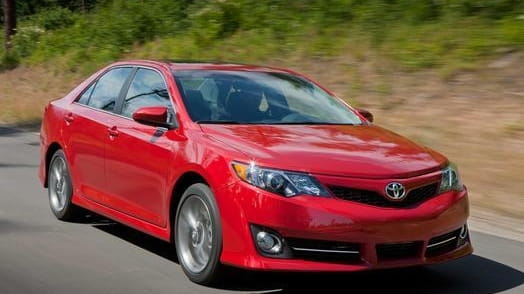Toyota Camry, Prius V get 'poor' marks in IIHS safety tests

The 2013 Toyota Camry earned a "poor" rating in the International Institute of Highway Safety's tests in December 2012. Credit: Toyota
Toyota Motor Corp.’s Camry, the best-selling mid-size car in the U.S., and the Prius V hybrid earned the lowest ratings in a new crash test simulating a severe front-end collision, an insurance group found.
The two Toyotas received the only “poor” scores on an Insurance Institute for Highway Safety test intended to evaluate a crash in which the front corner of a vehicle collides with another car, a tree or a pole. It is more stringent than the U.S. government’s test, which simulates a collision in which two vehicles or objects meet head on.
“Toyota engineers have a lot of work to do to match the performance of their competitors,” Adrian Lund, the insurance group’s president, said in a statement.
The insurance-industry funded group, based in Arlington, said it introduced its so-called small-overlap test this year because that type of accident accounts for almost a fourth of frontal crashes that seriously injure or kill people in front seats.
“With this new test, the institute has raised the bar again and we will respond to the challenge,” Brian Lyons, a Toyota spokesman, said in an e-mail. “We are evaluating the new test protocols and can say that there will not be one single solution to achieve greater crash performance in this area.”
Test results showed mid-size cars such as Honda Motor Co.’s Accord and Suzuki Motor Corp.’s Kizashi that had “good” ratings performed better than most comparable luxury models.
The insurance group released scores for mid-size luxury cars in August, finding most of the 11 models scored “marginal” or “poor” in the new test.
Crashes, Cost
“It’s remarkable that this group of mid-size family cars did so much better than the mid-size luxury car group,” Lund said. “The difference is stunning. Thirteen of these mid-size cars offer better crash protection than all but three of their luxury counterparts, and at a price that’s easier on the wallet.”
The insurance institute gives automakers advance notice of its tests, which can affect consumers’ purchase decisions, so they can design cars to pass them. Honda, which redesigned the Accord for 2013, this week earned praise for its top-selling vehicle from Consumer Reports magazine.
Of the 18 mid-size cars tested by the insurance institute, 11 earned “acceptable” ratings and two were rated “marginal,” in additional to the two with “good” scores and the two Toyotas dubbed “poor.”
The insurance group’s test is “the first in the world to address the risk of severe offset crashes,” Lynda Tran, a spokeswoman for the U.S. National Highway Traffic Safety Administration, which performs the government’s crash tests, said in an e-mail. The agency wants to see what safety benefits the testing yields, she said.
Dummy damage
The Camry and Prius V hybrid wagon were IIHS top safety picks in the crash tests that existed before this year. In those two cars, the only Toyotas to undergo the new test, structural components intruded into front-seat space where a driver would sit, the group said.
In the Camry, the crash shoved the front wheel into the footwell, bent the windshield pillar and pushed the parking brake pedal and left outer edge of the instrument panel back far enough to crush the driver’s body parts, the insurance group said. It said there was “significant” intrusion in the Prius V test coupled with “high forces” measured in a crash test dummy’s legs and feet.
Those cars’ air bags deployed too late or not in locations to protect drivers, the test found.
Honda credited a vehicle frame that it’s used for a decade and is designed to disperse crash energy for its success on the new test. Honda crashes 40 to 50 cars when it’s designing a new model and does more computer-simulated crashes, Chuck Thomas, chief engineer for automotive safety research, said yesterday on a conference call with reporters.
Honda, based in Tokyo, crash-tests its cars in Tochigi, Japan, and at its North American research and development center in Raymond, Ohio.
Top picks
With the addition of the new test, IIHS added a higher designation of vehicles getting its top-safety designation for next year. Most categories of vehicles haven’t undergone the new test yet, and the insurance institute said it will add to its top safety picks next year as it conducts more tests.
Vehicles on the list for 2013 models are: Chrysler Group LLC’s 200 four-door and Dodge Avenger; Ford Motor Co’s Fusion; Honda’s four-door and two-door Accords and Acura TL; Kia Motors Corp.’s Optima; Nissan Motor Co.’s Altima four-door; Fuji Heavy Industries Ltd.’s Subaru Legacy and Outback; Suzuki’s Kizashi; Volkswagen AG’s Passat and Volvo Cars’ S60.
The Kizashi, which got one of the best scores in the new crash test, was previously rated “acceptable” for roof strength so it wasn’t a top safety pick. Suzuki, based in Hamamatsu, Japan, said in November it will end car sales in the U.S.
In 2011, 32,367 people died in traffic crashes, the lowest number since 1949, the U.S. National Highway Traffic Safety Administration said last week.
